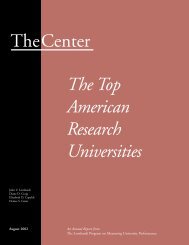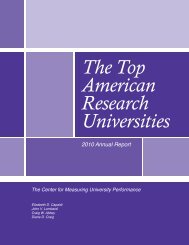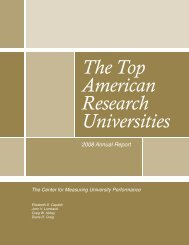2007 Annual Report, (PDF) - The Center for Measuring University ...
2007 Annual Report, (PDF) - The Center for Measuring University ...
2007 Annual Report, (PDF) - The Center for Measuring University ...
- No tags were found...
Create successful ePaper yourself
Turn your PDF publications into a flip-book with our unique Google optimized e-Paper software.
<strong>The</strong> Top American Research Universitiesin one area as “heavy” and label those with 50-74% of theirexpenditures concentrated as “strong.” Other universities with25-49% in one or more disciplines we describe as “moderate.”A few institutions (but none in the more than $20 million group)have expenditures distributed fairly evenly across the disciplines;those we code as “mixed.”In some cases, where an institution reports as a multi-campusentity, we made adjustments to break out the discipline-levelexpenditure data by single campus. Typically, this involved movingall or a portion of the life sciences expenditures to the healthor medical center campus. IPEDS fall enrollment and graduatedegrees by discipline data also were used to help in this ef<strong>for</strong>t.While these data offer some insight as to the research structureof a university, their usefulness is limited. For example, we maybe tempted to use the life sciences as a surrogate <strong>for</strong> medicalresearch, but we must remember that they also include agriculturaland biological sciences. Further, the growing trend towardmultidisciplinary and interdisciplinary projects may make it moredifficult <strong>for</strong> universities to accurately reflect expenditures bydiscipline or sub-discipline. <strong>The</strong><strong>Center</strong> chooses not to break outthese sub-disciplines because the data are increasingly prone toerror as further adjustments are made.Student CharacteristicsFall EnrollmentSource: NCES IPEDS Fall Enrollment Survey, 2005.Each November, institutions report their current fall headcountenrollment to the IPEDS Fall Enrollment Survey. Enrollment figuresinclude both degree seeking and non-degree seeking students.<strong>The</strong><strong>Center</strong> provides the headcount enrollment by level as presentedby IPEDS, along with the percentage of those attendingpart-time. Graduate students include those seeking specialistdegrees in engineering and education. First professional studentsinclude those seeking degrees in medical fields, such as Chiropractic,Dentistry, Medicine, Optometry, Osteopathic Medicine,Pharmacy, Podiatry, and Veterinary Medicine, as well as thoseseeking degrees in Law and <strong>The</strong>ology.Each campus in our study submits enrollment data by campus,except <strong>for</strong> the few institutions identified in our Data Notessection. Because this is an in<strong>for</strong>mational item and not one of<strong>The</strong><strong>Center</strong>’s nine quality measures, we did not attempt to adjustthese figures.1 Academic R&D Expenditures, FY 2000: Technical Notes(On-line: http://www.nsf.gov/sbe/srs/nsf02308/secta.htm)2 National Patterns of R&D Resources, 1998: Technical Notes(On-line: http://www.nsf.gov/sbe/srs/nsf99335/appa.htm3 College and <strong>University</strong> Higher Education Price Index, <strong>2007</strong>Update, Research Associates of Washington, Washington, DC.4 National Patterns of R&D Resources, 1998: Technical Notes(On-line: http://www.nsf.gov/sbe/srs/nsf99335/appa.htm)5 Survey Methodology: Survey of Graduate Studentsand Postdoctorates in Science and Engineering (On-line:http://www.nsf.gov/statistics/srvygradpostdoc/)6 Concordance Between SAT I and ACT Scores <strong>for</strong>Individual Students, Research Notes 07, June 1999 (On-line:http://www.collegeboard.org/research/html/rn_indx.html.)220<strong>The</strong> <strong>Center</strong> <strong>for</strong> <strong>Measuring</strong> <strong>University</strong> Per<strong>for</strong>mance








